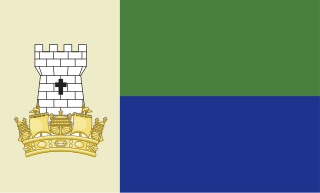
The Isle of Portland is a tied island, 6 kilometres (4 mi) long by 2.7 kilometres (1.7 mi) wide, in the English Channel. The southern tip, Portland Bill lies 8 kilometres (5 mi) south of the resort of Weymouth, forming the southernmost point of the county of Dorset, England. A barrier beach called Chesil Beach joins Portland with mainland England. The A354 road passes down the Portland end of the beach and then over the Fleet Lagoon by bridge to the mainland. The population of Portland is 13,417.

Weymouth and Portland was a local government district and borough in Dorset, England. It consisted of the resort of Weymouth and the Isle of Portland, and includes the areas of Wyke Regis, Preston, Melcombe Regis, Upwey, Broadwey, Southill, Nottington, Westham, Radipole, Chiswell, Castletown, Fortuneswell, Weston, Southwell and Easton; the latter six being on the Isle of Portland.
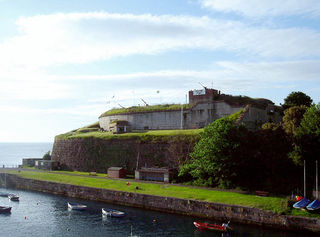
Nothe Fort is a fort in Weymouth, Dorset, England, situated at the end of the Nothe Peninsula, which juts eastwards from the town of Weymouth, and Weymouth Harbour, into the sea to the north of the ex-military Portland Harbour. The fort is located next to Nothe Gardens.

Sandsfoot Castle, also known historically as Weymouth Castle, is an artillery fort constructed by Henry VIII near Weymouth, Dorset. It formed part of the King's Device programme to protect against invasion from France and the Holy Roman Empire, and defended the Weymouth Bay anchorage. The stone castle had an octagonal gun platform, linked to a residential blockhouse, and was completed by 1542 at a cost of £3,887. Earthwork defences were built around the landward side of the castle, probably in 1623. Sandsfoot saw service during the English Civil War, when it was held by Parliament and Royalists in turn during the conflict. It survived the interregnum but, following Charles II's restoration to the throne, the fortress was withdrawn from military use in 1665.

Melcombe Regis is an area of Weymouth in Dorset, England.

South Dorset is a constituency represented in the House of Commons of the UK Parliament since 2010 by Richard Drax, a Conservative. The constituency was created as a consequence of the Redistribution of Seats Act 1885, although the area covered has changed since then.
Weymouth and Melcombe Regis was a borough in England. It was formed by a charter of Elizabeth I, amalgamating the towns of Weymouth and Melcombe Regis in 1571.
Radipole was is a suburb of Weymouth in Dorset, England.
Weymouth and Portland Borough Council in Dorset, England existed from 1974 to 2019. One-third of the council was elected each year, followed by one year where there was an election to Dorset County Council instead. The council was abolished and subsumed into Dorset Council in 2019.
Weymouth and Melcombe Regis was a parliamentary borough in Dorset represented in the English House of Commons, later in that of Great Britain, and finally in the Parliament of the United Kingdom. It was formed by an Act of Parliament of 1570 which amalgamated the existing boroughs of Weymouth and Melcombe Regis. Until 1832, the combined borough continued to elect the four Members of Parliament (MPs) to which its constituent parts had previously been entitled; the Great Reform Act reduced its representation to two Members, and the constituency was abolished altogether in 1885, becoming part of the new South Dorset constituency.
Elections to Weymouth and Portland Borough Council in Dorset, England were held on 1 May 2008. One third of the council was up for election and the council stayed under no overall control as it has been since 1980.
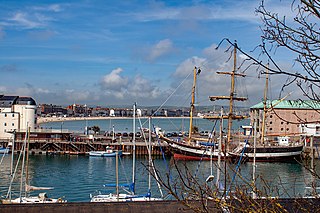
Weymouth is a seaside town in Dorset, on the English Channel coast of England. Situated on a sheltered bay at the mouth of the River Wey, 11 kilometres (7 mi) south of the county town of Dorchester, Weymouth had a population of 53,427 in 2021. It is the third largest settlement in Dorset after Bournemouth and Poole.
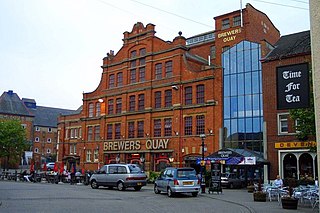
Weymouth Museum is a museum in Weymouth, Dorset, England. Its permanent home is in Brewers Quay on the south side of Hope Square near Weymouth Harbour. However, due to redevelopment of the building, it is currently operating from a pop-up shop at 40b St Thomas Street in Weymouth.
The 2010 Weymouth and Portland Borough Council election took place on 6 May 2010 to elect members of Weymouth and Portland Borough Council in Dorset, England. One third of the council was up for election and the council stayed under no overall control.
Cotton Fort was a small fortification in Melcombe, now part of the town of Weymouth, Dorset. No trace of the fort exists today.

Weymouth Town Bridge is a lifting bascule bridge in Weymouth, Dorset, England, connecting the formerly separate boroughs of Weymouth and Melcombe Regis. The bridge can be lifted to allow boats access to the inner backwater of Weymouth Harbour, known as Weymouth Marina. The bridge, opened in 1930, is the sixth to have been built across the harbour since 1597 and has been Grade II Listed since 1997. Today, the hydraulically-operated bridge is raised every two hours, 363 days of the year.

St Mary's Church is a Church of England parish church in Weymouth, Dorset, England. Built of Portland stone in 1815–1817, the church has been described as having an "austere design in Palladian mode". It has been a Grade I listed building since 1953.

Weymouth Old Town Hall is a former town hall at Weymouth, Dorset, England. The building, which was built with Portland stone in the 1770s, has been Grade II listed since 1953. The bell turret is believed to date from the 17th century. Since 2009, the hall has been operated for community use by the Guardians of the Old Town Hall.
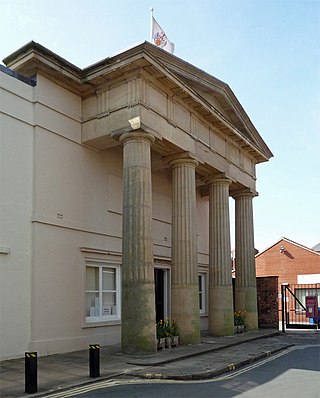
The Guildhall is a municipal facility at Register Square in Beverley, East Riding of Yorkshire, England. It is a Grade I listed building.

Weymouth Bay Methodist Church is a Methodist church in Weymouth, Dorset, England. It was built in 2008–09 to replace the Maiden Street Methodist Church of 1866–1870 which was gutted by fire in 2002.














